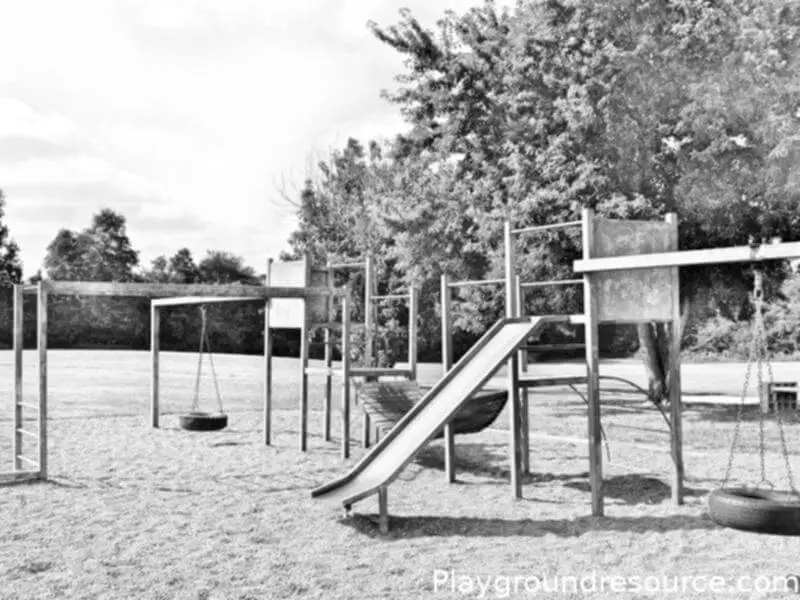
Take a good look at today’s modern playgrounds and you’ll see a lot has significantly changed. Old favorites like the traditional jungle gyms or monkey bars and merry-go-rounds can still be found, but are quite different.
Swing sets, see-saws, tubes, spring riders, and slides now come in more vivid colors, customized designs, and advanced, more durable and lighter materials. Soon, the giant metal slides, dangerous giant strides, and hard-hitting see-saws will become extinct.
And taking their place will be state-of-the-art, safer, and more exciting play structures for youngsters. In this article we’ll take a stroll into the playground past, covering all of the classics while also looking at the modern versions.
Table of Contents
Different Types of Classic Playground Equipment
Who could forget these timeless pieces of playground equipment? Each one the classics mentioned below will surely be etched forever in the memories of parents and children alike.
But all is not lost for these timeless classics, there are newer, safer designs and more durable materials that have allowed these classics to evolve into the modern versions we know today– let’s take a look.
Merry-Go-Rounds
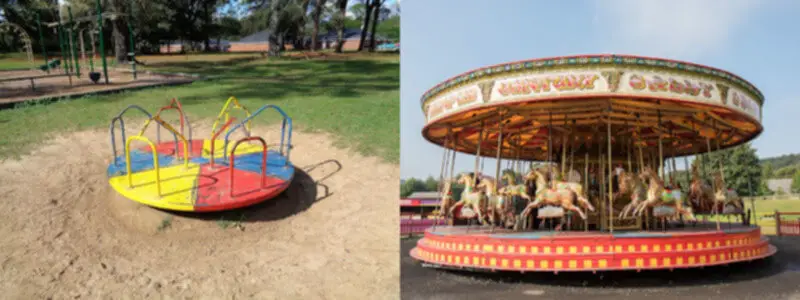
Many of us will never forget these majestic “flying horses” known as merry-go-rounds, carousels or roundabouts. History says that several immigrants from Europe introduced the creativity and fondness for this carousel somewhere in Brooklyn during the 1800s.
The emergence of the Industrial Revolution during this period resulted in the mass production of bigger amusement fixtures.
You also had the playground version. This heavy, fast and oftentimes dangerous device that was made of solid metal would seem to spin at warp speed. These can still be found, but they don’t make them like they used to.
Modern Merry-Go-Rounds
The nostalgia for the traditional carousel can still be satisfied at state and county fairs and some amusement parks. Modern merry-go-rounds you see in playground and backyards have evolved into safer, more complex and fun pieces of equipment.
Modern “merry-go-rounds” are usually lighter, safer, more compact in size and do more than just spin.
Here is a fun backyard version of the classic.
See-Saw
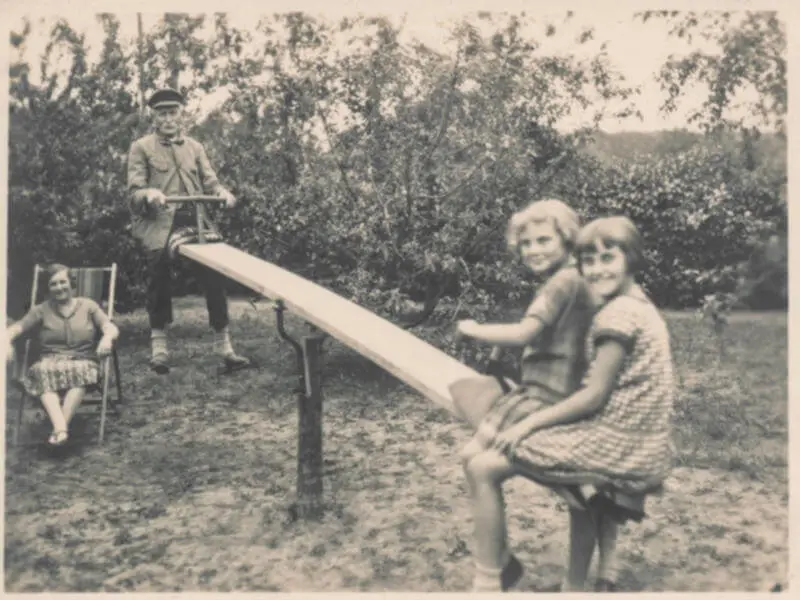
The traditional see-saw, also known as the teeter-totter and teeter-board provides absolute fun for kids on both ends of the long and narrow board propped up by a sole pivot point.
One goes up while the other goes down alternately. The see-saw supposedly originated from France in the 1500s and reference to the up and down motion on a balanced plank was recorded during the early 1700s.
According to the New York Times, some 600 playgrounds in New York City between 1930 and 1964 were filled with see-saws.
The classic version was often larger, heavier, and more dangerous. Ever had your see-saw partner suddenly jump off and send you plummeting down? It was a hard landing.
Modern See-Saws
A newspaper article in 2016 described the see-saw as a piece of dying playground equipment. But this is far from the truth as contemporary playgrounds feature newer versions made of plastic and lighter metals with rubber mats for cushioning falls and pads to protect kids’ backsides from getting bruised.
On most modern see-saws you’ll now see some sort of cushion to prevent the aforementioned hard landing. Nowadays they not only go up and down but many will also spin a full 360 degrees while others let you stand up.
Here is a very popular see-saw that does spin a full 360 degrees. Loads of fun and very durable.
Monkey Bars
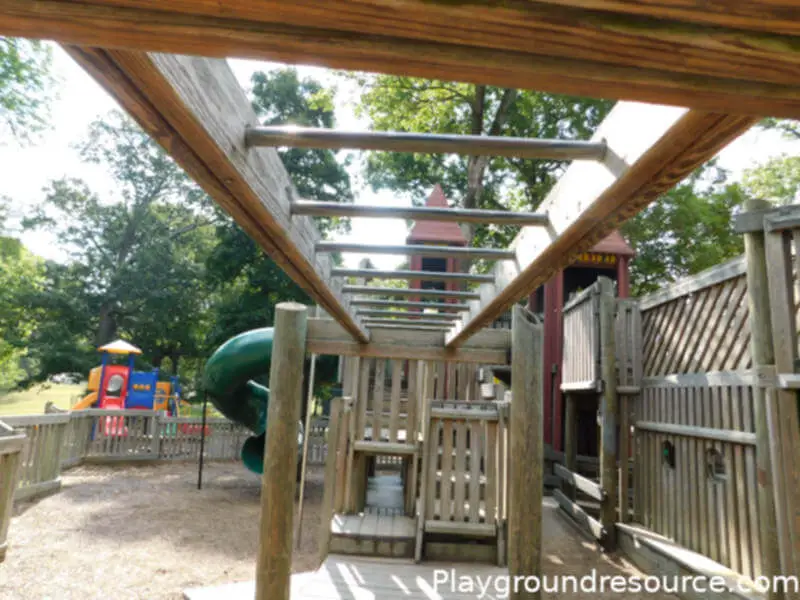
The first monkey bars/jungle gym was invented in 1920 by a lawyer named Sebastian Hinton from Chicago. During those days, kids loved to climb and swing on the structure similar to monkeys swinging through the trees.
The vintage Jungle Gym was a familiar sight in public leisure areas although many parents considered this iconic structure as unsafe for children. Tall, with often slippery metal, and no safe ground cover to cushion your fall it could be treacherous- but was fun!
Modern Monkey Bars
You can still find the classic monkey bars and jungle gyms in most playgrounds. However, resourceful designers and builders have come up with newer designs that allow for more complex climbing while still conforming to today’s strict safety standards.
Modern climbing frames are made from superior materials and most often have many safety features that the classic ones didn’t.
Here is a “portable” version that requires no frame.
Ball Pit

Industrial designer Eric McMillan from Canada invented the ball pit or ball crawl in 1976 at Ontario Place, a renowned theme park off the waterfront of Toronto.
The padded pool or play area was filled with small, multi-colored plastic balls (about three inches in diameter) meant for the play of toddlers.
Ball pits were found more often back in the day in fast-food restaurants, amusement parks, carnivals, and fun areas (who can forget the old ball pit at Chuck E. Cheese?).
Does anyone remember loosing the change or other items out of your pocket in a ball pit? I know I do!
Modern Ball Pit
Ball pits have often been described as unhealthy and a “hive of germs” aside from posing safety risks to children. Parents need not worry anymore.
Modern ball pits are much more sanitary and the balls are made differently, usually from 100% non-recycled plastic, washable, and free from phthalate (chemical compounds), lead-free and non-toxic, and PVC-free.
So in other words, they are much safer and sanitary. Now anyone can have a ball pit at their home thanks to modern design and lighter materials.
Here is a very cool, portable and lightweight ball pit that can be used in or outdoors.
Giant Stride
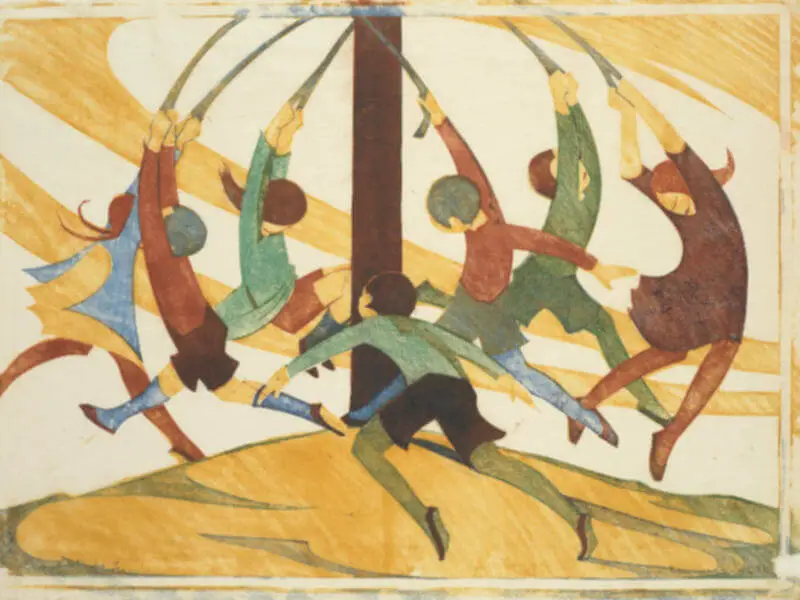
The giant stride dates back to the early 1900s but has long been removed from playgrounds for safety reasons. This tall pole (most often 12 feet high) has ropes and ladders allowing kids to grab the handles and run in circles.
They go very fast and their feet leave the ground as they are sent spinning through the air. It was banned in the 1980s and nearly disappeared until modern versions came along.
Modern Giant Stride
Modern variations of the Giant Stride are now referred to as “grab and spin” play equipment.
Witches hats and other grab and spin equipment have employed modern design and construction techniques to observe safety policies without eliminating the thrills and pleasure the giant stride creates for children.
Here is a safe, versatile and very fun modern version. Be sure to check out the other pictures of this product to see what all this thing can do when you click the link.
Dome Climber
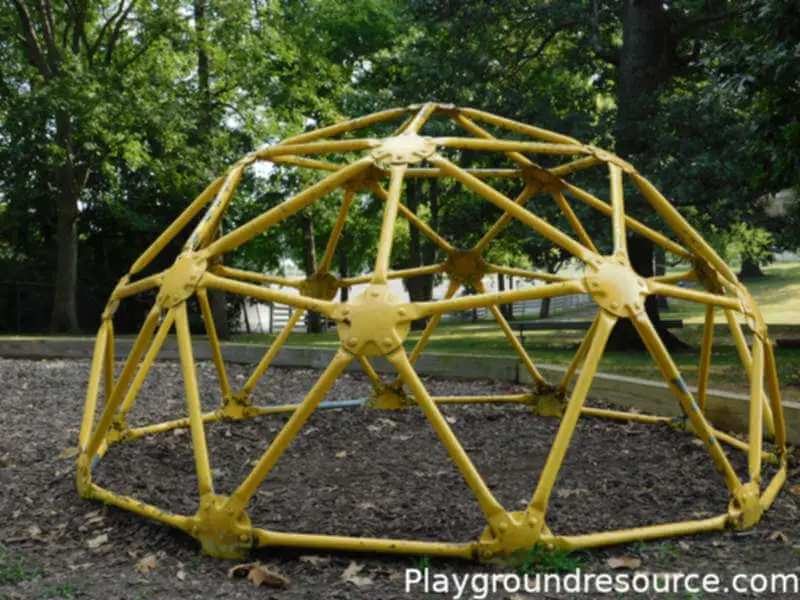
The classic dome climber or geometric dome can still be found in some playgrounds across the world, but most of the classic, large domes have been removed for safety reasons.
The main safety issue was the very large size (which meant a long fall to the ground if you slipped or lost your grip), slippery metal and absence of playground padding.
Modern Dome Climber
Modern dome climbers are fabricated from safe plastic and lighter, stronger metals and are supported at certain points to comply with safety standards.
The innovative progress in dome climbers makes it safe yet challenging for kids and parents alike. Modern versions are lighter, more slip-resistant, and often smaller than the classic version.
And here is the modern version. Not much has changed in terms of look, but this dome is safer, more durable and lighter than the classic.
Metal Slides
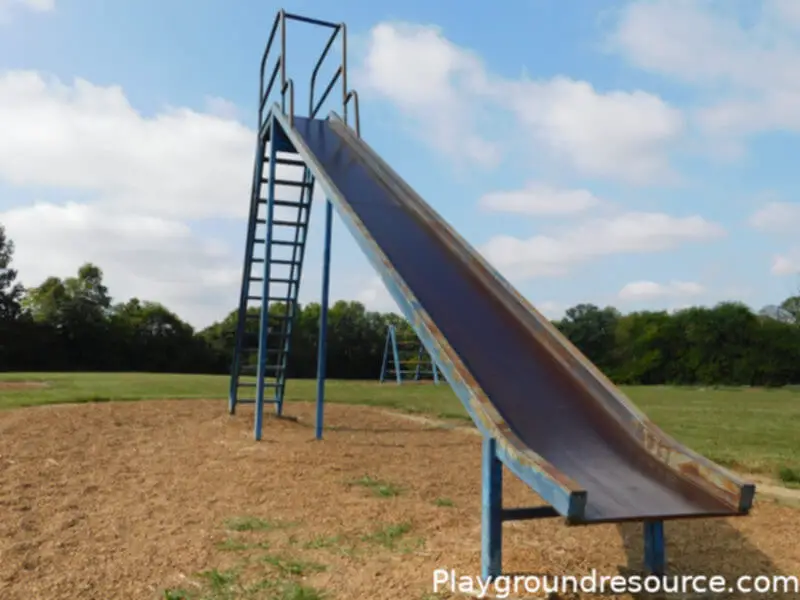
Large metal slides were considered an integral part of playgrounds, almost every park playground, and schoolyard was equipped with a colossal metal slide.
The first metal slide is said to have been invented by an English engineer, Charles Wicksteed in 1922. These used to be very steep and hazardous especially for toddlers.
Modern Slides
The modern slide is not as steep as before unless it is tubular or has added safety features. Advances in playground surfacing also means that falling on the ground is not as risky like in the past.
Slides manufactured today can be cemented in the ground or designed as free-standing and come in many different variations. For more interesting, in-depth information on playground slides check out our article titled, “What are playground slides made of – Materials Explained“
Here is a very modern version of the slide. This is an 8-foot free-standing “water” slide. You can opt-out of using water on colder days. Very durable and lots of fun.
Wooden Swing Seats
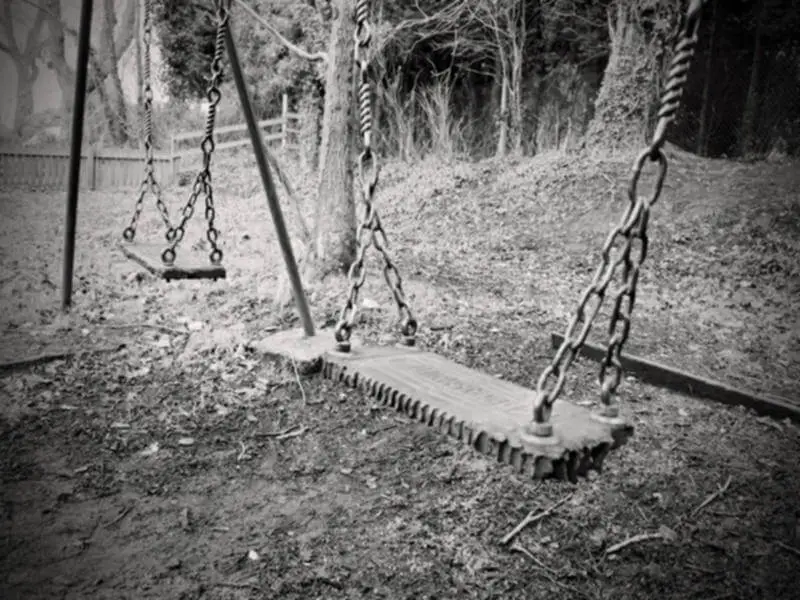
The swing has always been a part of children’s play. This classic seat is a simple wooden plank with holes in each end and is supported using a braided rope or a chain. According to history, the wooden swing seat was used as far back as 1450 in Ancient Greece.
Modern Swing Seats
The contemporary swing seat comes in many shapes and sizes, is made of lighter, more durable materials and is much more comfortable and safer.
Materials are usually made of sturdy plastic and rubber. There are swing seats for toddlers, kids, and adults that come in all shapes and sizes.
The swing may be the oldest piece of playground equipment and has come a very long way. Check out our article titled “Different Types of Playground Swings – Ultimate Guide” to see how far they have come.
The modern version has changed very little. A few changes in the design to make it more comfortable is all.
Tetherball

This is a fun, conventional playground game that is suitable for small backyards and large areas alike, but you were probably introduced to this game on the schoolyard. Based on historical records, Tether Ball was invented in England or Ireland in 1875.
It consists of a ball connected to a rope that is tethered a pole. The pole’s height and ball’s size vary. For smaller children, it is ideal to have a shorter post with a bigger ball. I can remember many a recess playing this game!
Modern Tether Ball
Unlike older sets, the modern tetherball set can be portable or fixed on the ground. The majority of sets sold today have softer balls that don’t irritate the hands.
The tetherball pole is usually made from corrosion-resistant galvanized steel or hard plastic making it more durable and less prone to rust.
Here we see that the modern version can be portable and just as durable as the fixed in-ground versions.
Still Rings
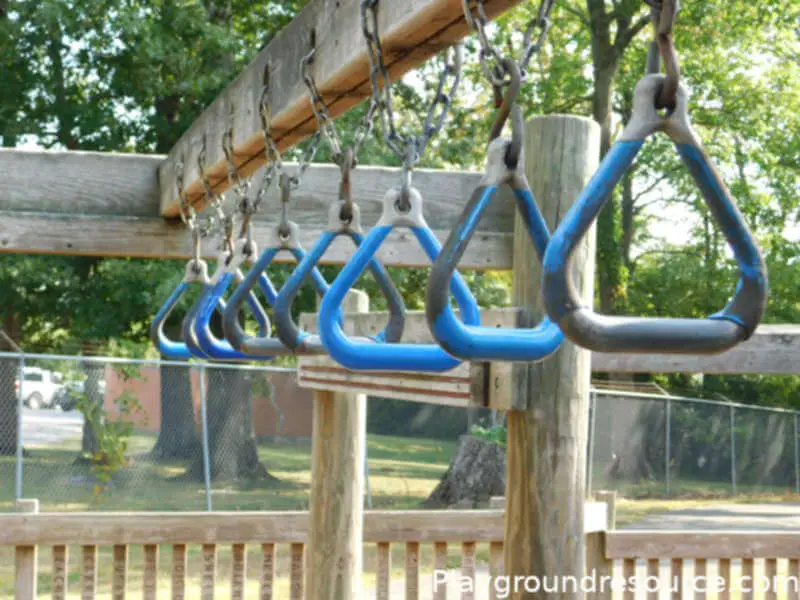
Still rings hang on short or long chains so children can on the swing and climb. They are like an advanced version of the original monkey bars. This classic can still be found on many playgrounds.
Modern Still Rings
Modern still ring models are found on most playgrounds. Most often, these are branded as therapeutic or curative hand rings fitted with shorter chains.
Youngsters can use this equipment to practice upper body strength by reinforcing their body weight while hanging from said rings. They come in many different designs and variations.
Of the many variations available to the classic still rings, here we still have something very similar. Except these are more durable, offer a much better grip and are “portable”, as in you can attach and re-attach them anywhere.
Animal Spring Riders
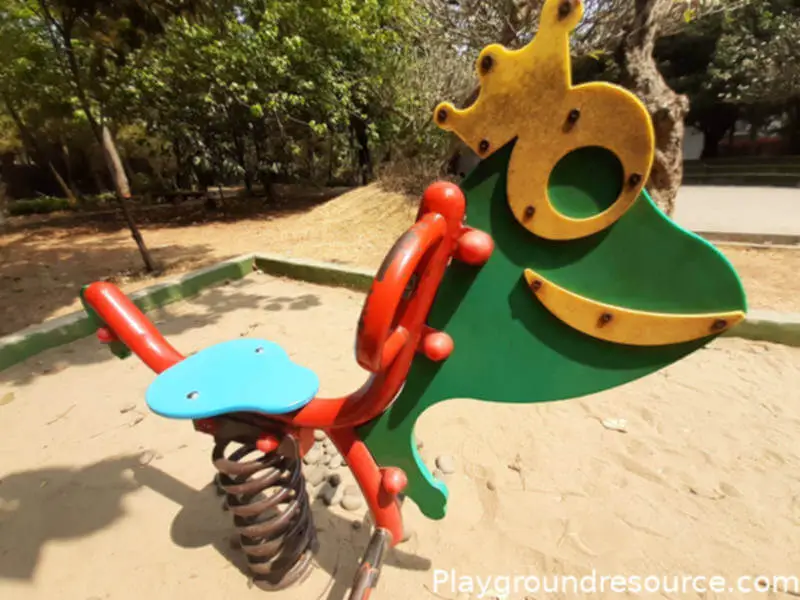
The animal spring rider or rocker is said to have been invented in the 1970s in Denmark. The rider consisted of a large metal spring with one end attached to the ground and the other end attached to the “seat”.
The spring rider most often took the form of an animal.
Modern Spring Riders
Modern spring riders have been conceived in different colors and shapes to drum up more thrill for the children. The spring riders are designed either as bugs, animals or cars to stir up the kids’ imagination.
The materials are made from durable plastic or steel and are easy to hop on with handles and foothold perfect for younger riders. Some models are made for older children (a maximum of 12 years old).
The modern spring rider is not only more comfortable and safe but also more visually appealing igniting the young imagination.
Here is a very cool version of the original spring rider. These have been around a long time, but the concept is the same. This is portable, durable, comfortable, and will spark the imagination of your little one.
Final Thoughts and Considerations
Classic playground equipment has steadily evolved over the years and will continue to do so. These slides, see-saws, ball pits, giant strides, and others have undergone a meaningful change primarily for the safety of the children.
Modern designs and materials will now allow us to have safer, more compact, and lighter variations of these classics. I hope you’ve enjoyed this article, remember to stay safe and have fun!

Kathryn
Over 14 years in special education with a BA in psychology. I work daily with children of all kinds, with a special focus on childhood development and play using music and play equipment among other tools.
